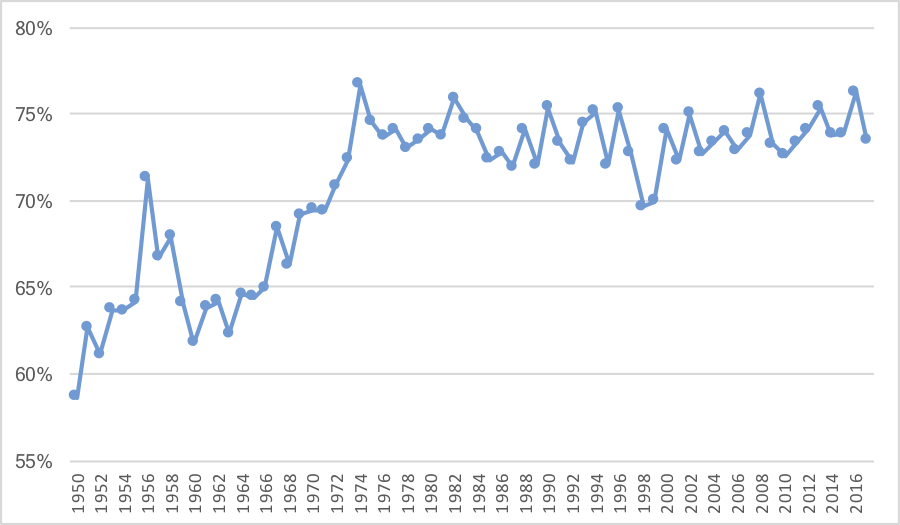Thanks to the always wonderful PFR Play Index, it’s easy to analyze NFL pass plays by direction. The official play-by-play logs released on behalf of the league label all passes as either short (less than 15 yards from the line of scrimmage) or deep, and either left, middle, or right.
The table below shows the results of passes last year in those six directions, along with the totals:

A few things stand out. NFL teams have a slight preference for throwing right rather than throwing left, which likely reflects (or is a cause of!) the fact that every quarterback in the NFL is now exclusively righthanded. The effect is not large, but there are slightly more short passes to the right than the left.
Another is that passes in the middle of the field seem very good, but with two big caveats. On short passes, teams averaged 7.41 Y/A and pick up a first down on 40% of all throws; meanwhile, teams averaged 5.93 Y/A and a 32% first down rate on short throws to the left or right. That makes passes to the short middle appear about 20% more efficient than passes that are thrown short and outside. And on deep throws, the completion percentage is significantly higher on throws in the middle of the field (46% vs. 37%), with higher first down rates (duh) and AY/A averages, too.
Ah, but the caveats. One is that throws in the middle of the field are less safe, almost certainly due to the heavy congestion. The interception rate was twice as high on short throws last season as it was on short throws to the outside, and it was also twice as high on deep middle throws relative to passes deep and to the outside. Throwing in the middle of the field is riskier, but it appears to have a higher reward.
We’ll get to the other caveat in a minute, but first, let’s look at passes from 2013 to 2016, again using the PFR Game Play Finder.

We see similar results here. The NFL still looks like a right-handed league, with just a few more passes coming to the right than the left. On short passes, the interception rate is much higher on passes to the middle of the field, but the Y/A and first down rates are also way higher. In fact, both AY/A and first down rates were 22% higher on passes short and to the middle relative to short and outside. On deep throws, completion percentage was significantly higher on throws in the middle of the field, as was the touchdown rate, first down rate, and well, the interception rate.
But the elephant in the room in this analysis isn’t that passes thrown in the middle of the field are more effective than passes thrown to the outside. Perhaps the most important data point in these tables isn’t even given its own column, but savvy readers likely picked up on it. On short passes, just under 25% of them (in both 2017 and 2013-2016) were thrown to the middle of the field; on deep passes, 22% of throws (2017 and 2013-2016) were to the middle of the field. Meanwhile, passes to the right (short/deep/2017/2013-2016) approach 40% in all cases.
This means we are not necessarily comparing apples to oranges. There is a likely survivorship bias going on here. I don’t have data on time from snap to throw, which would supplement (and make more interesting!) today’s analysis, but it seems likely that passes to the middle of the field happen quicker. In other words, a quarterback is much more likely to do this:
Read 1 is to middle of the field —–> player covered —-> Read 2 –> throw to outside
Than to do to this
Read 1 is to outside of the field —–> player covered —-> Read 2 –> throw to middle of field
If your first option is covered, that play’s overall success rate is likely going down. A “backup” plan is to throw to the outside, which would explain why passes to the outside are both greater in number and lower in efficiency.
And let’s not forget that targets themselves — or pass attempts, in this case — are also measures of quality. The fact that teams throw to the outside more is evidence (not conclusive, of course, but evidence nonetheless) that throwing to the outside more is better. Let’s consider the 2017 Eagles, with Alshon Jeffery and Torrey Smith (who spent most of their time on the outside) and the team’s slot receiver, Nelson Agholor, who had been heavily criticized much of his career. Agholor averaged 8.08 yards per target last year on 95 targets, while Jeffrey (6.58) and Smith (6.42) were much worse on 120 and 67 targets, respectively.
Let’s look just at short passes for the Eagles last year. Philadelphia quarterbacks had a 96.5 passer rating and picked up a first down on 31.5% of passes that were short and to the outside; meanwhile, those same players had a 119.6 passer rating and picked up a first down on 47.8% of passes that were short and in the middle of the field.
But for Philadelphia, short throws to the middle of the field comprised only 21% of all short throws. Perhaps, just like with Agholor, Philadelphia only threw to the middle of the field when the middle was open, and threw short no matter what (and if everyone was covered, a check down to the running back in the flat may be more likely to be charted as an outside pass).
It’s easy to look at efficiency numbers and conclude that teams should be doing more of what’s most efficient. But that only works when we’re comparing the same sort of data, and it’s not clear that we can do that just yet.











